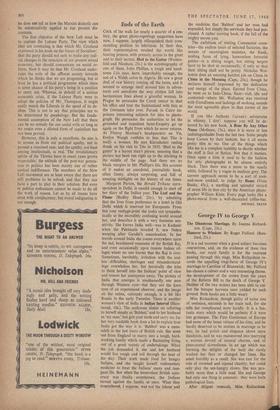Ends of the Earth
COCK of the walk for nearly a quarter of a cen- tury, the great photo-reportage magazines have now, I suppose, largely relinquished their com- manding position to television. In their day, their representatives strutted the world like touring princes, with princely access to the great and to their secrets. Bled to the Gutter (Weiden- feld and Nicolson, 25s.) is the autobiography of one of them, John Phillips, a tough and hand- some Life man, born, improbably enough, the son of a Welsh colon in Algeria. He saw a great deal of raw history coming off the loom, and it seemed to arrange itself around him in adven- tures and anecdotes the way clothes fall into harmonious lines about a graceful woman. In Prague he persuades the Czech censor to shut his office and tour the Sudetenland with him as the Germans take over. Farouk in Cairo im- prisons interesting subjects for him to photo- graph. He persuades the authorities to let the grounded and impatient Saint-Exupery go up again on the flight from which he never returns. At Fitzroy Maclean's headquarters on Vis, Evelyn Waugh confides to him that Tito is really a woman. He sees Khrushchev reeling drunk on his visit to Tito in 1955. 'Bled to the gutter' is a layout man's phrase, meaning that a picture has been run right up to the stitching in the middle of the page. And there are no blank margins in Mr. Phillips's life. His account of it makes an anecdotal, journalistic book, often funny, always surprising, and full of amazing sidelights on the history of our times.
the medicine that 'Babbot' and her man had expended, but simply the servitude they had pur- chased. A rather moving book, if the fall of the mighty moves you.
The awfulness of visiting Communist coun- tries—the endless tours of selected factories, the oceans of meaningless statistics, the frank, smiling faces of lying, humourless Intourist guides—is a sitting target, but sitting targets have to be shot at occasionally, if only so that their sitting shall not be pretty. Nicholas Wol- laston does an amusing hatchet job on China in China in the Morning (Cape, 25s.), though he declares himself impressed by the dedication and energy of the place. Ejected from China, he went on to lndo China. Siam—rich, idle and contented--where Mr. Wollaston was received with friendliness and lashings of mekong, sounds the most agreeable place in that corner of the world.
If you like Anthony Carson's adventures in whimsy, I don', suppose you will be de- terred by his new book, A Rose By Any Other Name (Methuen, 5s.), since it is more or less indistinguishable from the last two. Some people keep Carson by their bedside, but it all seems pretty thin to me. One of the things which irks me is a complete inability to decide whether the stuff is fact or fiction. Not that it matters. Once upon a time it used to be the fashion for arty photographs to be almost entirely black. Then there was a move to the nearly white, followed by a vogue in medium grey. The current approach seems to be a sort of soot- and-snow cocktail, to judge by Rome (Vista Books, 45s.), a startling and splendid record of street life in that city by the American photo- grapher William Klein. Every page looks like a photo-mural from a well-decorated coffee-bar. Margaret Parton, the Herald Tribune corre- spondent in Delhi, is candid enough to start off her diary of the Indian year, The Leaf and the Flame (Bodley Head, 21s.), by admitting that she lives from preference in a hotel in Old Delhi which is reserved for Europeans. From this cosy vantage-point she looks out sympathe- tically at the incredibly confusing world around her, and describes it with a very feminine sen- sitivity. She knows India well—was in Kashmir when the Pakistanis invaded it, saw Nehru weeping after Gandhi's assassination. In her travels around India she comes everywhere upon the sad, bewildered remnants of the British Raj, and even occasionally upon remote Indian vil- lages where no one knows that the Raj is over. Sometimes, inevitably, irritation with the end- less difficulties, shortages and misunderstand- ings overwhelms her, but heroically she tries to think herself into the Indians' point of view and reason her annoyance away. The picture of India that emerges is unashamedly one seen through Western eyes—but they are the keen eyes of an experienced observer, and the image on the retina, curiously enough, is a bit like Russia in the early Twenties. There is another woman's view of India in Indian Interval (Ham- mond, 16s.). The authoress insists on referring to herself simply as `Babbot,' and to her husband as 'my man,' but grit your teeth and carry on, for her very readable book does a lot to explain how India got the way it is. 'Babbot' was a mem- sahib in the last years of British rule. She went out from England to marry into a tough, hard- working family which made a fluctuating living out of a great variety of undertakings. When the job demanded it, she and her husband would live rough and toil through the heat of the 'day. Their work made food for hungry Indians, and she taught herself rudimentary medicine to treat the Indians' many and ram- pant ills. But when the benevolent British auto- cracy was finally overthrown, the Indians turned against the family at once. What they remembered, I suppose, was not the labour and
MICHAEL FRAYN










































 Previous page
Previous page